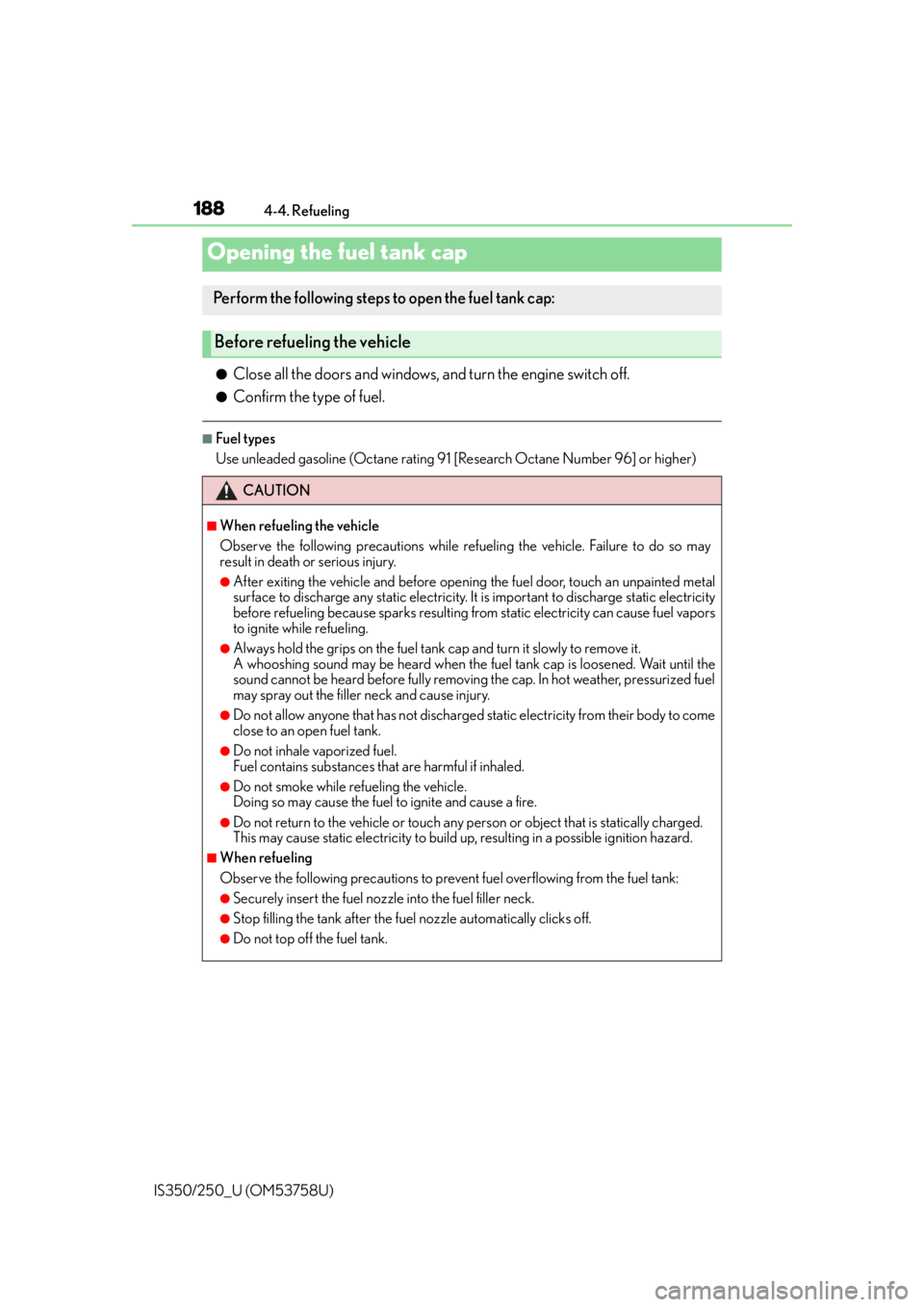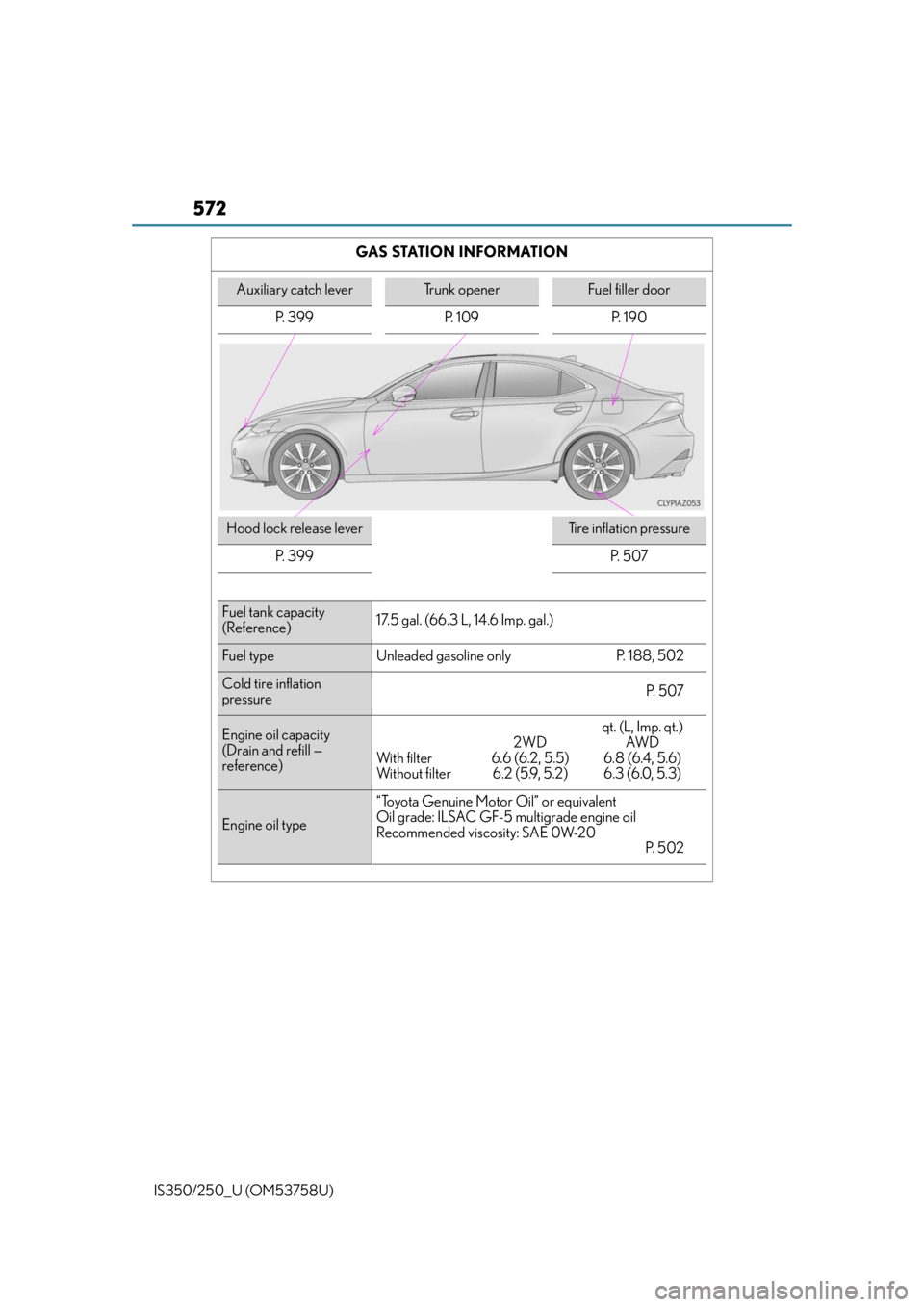2014 Lexus IS250 gas cap
[x] Cancel search: gas capPage 149 of 573

1484-1. Before driving
IS350/250_U (OM53758U)
CAUTION
Observe the following precautions.
Failure to do so may result in death or serious injury.
■When starting the vehicle
Always keep your foot on the brake pedal while stopped with the engine running. This
prevents the vehicle from creeping.
■When driving the vehicle
●Do not drive if you are unfamiliar with the location of the brake and accelerator ped-
als to avoid depressing the wrong pedal.
• Accidentally depressing th e accelerator pedal instead of the brake pedal will
result in sudden acceleration that may lead to an accident.
• When backing up, you may twist your body around, leading to a difficulty in oper-
ating the pedals. Make sure to operate the pedals properly.
• Make sure to keep a correct driving posture even when moving the vehicle only slightly. This allows you to depress th e brake and accelerator pedals properly.
• Depress the brake pedal using your righ t foot. Depressing the brake pedal using
your left foot may delay response in an emergency, resulting in an accident.
●Do not drive the vehicle over or stop the vehicle near flammable materials.
The exhaust system and exhaust gases can be extremely hot. These hot parts may
cause a fire if there is any flammable material nearby.
●During normal driving, do not turn off the engine. Turning the engine off while driving
will not cause loss of steering or braking co ntrol, but the power assist to these systems
will be lost. This will make it more difficul t to steer and brake, so you should pull over
and stop the vehicle as soon as it is safe to do so.
However, in the event of an emergency, such as if it becomes impossible to stop the
vehicle in the normal way: P. 4 4 7
●Use engine braking (downshift) to maintain a safe speed when driving down a steep
hill.
Using the brakes continuously may cause th e brakes to overheat and lose effective-
ness. ( P. 1 6 4 )
●Do not adjust the positions of the steering wh eel, the seat, or the inside or outside rear
view mirrors while driving.
Doing so may result in a loss of vehicle control.
●Always check that all passengers’ arms, heads or other parts of their body are not
outside the vehicle.
●Do not drive in excess of the speed limit. Ev en if the legal speed limit permits it, do not
drive over 85 mph (140 km/h) unless your vehicle has high-speed capability tires.
Driving over 85 mph (140 km/h) may result in tire failure, loss of control and possible
injury. Be sure to consult a tire dealer to determine whether the tires on your vehicle
are high-speed capability tires or not before driving at such speeds.
Page 156 of 573

1554-1. Before driving
4
Driving
IS350/250_U (OM53758U)
CAUTION
■Things that must not be carried in the trunk
The following things may cause a fire if loaded in the trunk:
●Receptacles containing gasoline
●Aerosol cans
■Storage precautions
Observe the following precautions.
Failure to do so may prevent the pedals from being depressed properly, may block the
driver’s vision, or may result in items hittin g the driver or passengers, possibly causing
an accident.
●Stow cargo and luggage in the trunk whenever possible.
●To prevent cargo and luggage from sliding forward during braking, do not stack any-
thing in the enlarged trunk. Keep cargo and luggage low, as close to the floor as pos-
sible.
●When you fold down the rear seats, long items should not be placed directly behind
the front seats.
●Never allow anyone to ride in the enlarged trunk. It is not designed for passengers.
They should ride in thei r seats with their seat belts properly fastened.
●Do not place cargo or luggage in or on the following locations.
• At the feet of the driver
• On the front passenger or rear seats (when stacking items)
• On the package tray
• On the instrument panel
•On the dashboard
• In front of the navigation system scre en (if equipped) or Lexus Display Audio
screen (if equipped)
●Secure all items in th e occupant compartment.
■Capacity and distribution
●Do not exceed the maximum axle weight ra ting or the total vehicle weight rating.
●Even if the total load of occupant’s weight and the cargo load is less than the total load
capacity, do not apply the load unevenly. Improper loading may cause deterioration
of steering or braking control which may cause death or serious injury.
Page 189 of 573

188
IS350/250_U (OM53758U)4-4. Refueling
●Close all the doors and windows, and turn the engine switch off.
●Confirm the type of fuel.
■Fuel types
Use unleaded gasoline (Octane rating 91 [Research Octane Number 96] or higher)
Opening the fuel tank cap
Perform the following steps to open the fuel tank cap:
Before refueling the vehicle
CAUTION
■When refueling the vehicle
Observe the following precautions while refu
eling the vehicle. Failure to do so may
result in death or serious injury.
●After exiting the vehicle and before openin g the fuel door, touch an unpainted metal
surface to discharge any static electricity. It is important to discharge static electricity
before refueling because sparks resulting fr om static electricity can cause fuel vapors
to ignite while refueling.
●Always hold the grips on th e fuel tank cap and turn it slowly to remove it.
A whooshing sound may be heard when the fuel tank cap is loosened. Wait until the
sound cannot be heard before fully removing the cap. In hot weather, pressurized fuel
may spray out the filler neck and cause injury.
●Do not allow anyone that has not discharged static electricity from their body to come
close to an open fuel tank.
●Do not inhale vaporized fuel.
Fuel contains substances th at are harmful if inhaled.
●Do not smoke while refueling the vehicle.
Doing so may cause the fuel to ignite and cause a fire.
●Do not return to the vehicle or touch any person or object that is statically charged.
This may cause static electricity to build up, resulting in a possible ignition hazard.
■When refueling
Observe the following precautions to prevent fuel overflowing from the fuel tank:
●Securely insert the fuel nozzle into the fuel filler neck.
●Stop filling the tank after the fuel nozzle automatically clicks off.
●Do not top off the fuel tank.
Page 503 of 573
![Lexus IS250 2014 Headlight switch / LEXUS 2014 IS250,IS350 OWNERS MANUAL (OM53758U) 5029-1. Specifications
IS350/250_U (OM53758U)
■Oil capacity (Drain and refill [Reference*])
*: The engine oil capacity is a reference quantity to be used when changing the engine oil. Warm up and tu Lexus IS250 2014 Headlight switch / LEXUS 2014 IS250,IS350 OWNERS MANUAL (OM53758U) 5029-1. Specifications
IS350/250_U (OM53758U)
■Oil capacity (Drain and refill [Reference*])
*: The engine oil capacity is a reference quantity to be used when changing the engine oil. Warm up and tu](/manual-img/36/29773/w960_29773-502.png)
5029-1. Specifications
IS350/250_U (OM53758U)
■Oil capacity (Drain and refill [Reference*])
*: The engine oil capacity is a reference quantity to be used when changing the engine oil. Warm up and turn off the engine, wait more than 5 minutes, and check the oil level
on the dipstick.
Engine
IS250IS350
Model2.5 L 6-cylinder (4GR-FSE)
engine3.5 L 6-cylinder (2GR-FSE)
engine
Ty p e6-cylinder V type, 4-cycle, gasoline
Bore and stroke3.27 3.03 in.
(83.0 77.0 mm)3.70 3.27 in.
(94.0 83.0 mm)
Displacement152.5 cu. in. (2500 cm3)210.9 cu. in. (3456 cm3)
Valve clearance
(engine cold)Automatic adjustment
Drive belt tensionAutomatic adjustment
Fuel
Fuel typeUnleaded gasoline only
Octane Rating91 (Research Octane Number 96) or higher
Fuel tank capacity
(Reference)17.5 gal. (66.3 L, 14.6 Imp. gal.)
Lubrication system
2WDAW D
With filter6.6 qt. (6.2 L, 5.5 Imp. qt.)6.8 qt. (6.4 L, 5.6 Imp. qt.)
Without filter6.2 qt. (5.9 L, 5.2 Imp. qt.)6.3 qt. (6.0 L, 5.3 Imp. qt.)
Page 573 of 573

572
IS350/250_U (OM53758U)GAS STATION INFORMATION
Auxiliary catch leverTrunk openerFuel filler door
P. 399 P. 109 P. 190
Hood lock release leverTire inflation pressure
P. 3 9 9
P. 5 0 7
Fuel tank capacity
(Reference) 17.5 gal. (66.3 L, 14.6 Imp. gal.)
Fuel type
Unleaded gasoline only P. 188, 502
Cold tire inflation
pressure P. 5 0 7
Engine oil capacity
(Drain and refill —
reference)qt. (L, Imp. qt.)
2WD AWD
With filter 6.6 (6.2, 5.5) 6.8 (6.4, 5.6)
Without filter 6.2 (5.9, 5.2) 6.3 (6.0, 5.3)
Engine oil type “Toyota Genuine Motor Oil” or equivalent
Oil grade: ILSAC GF-5 multigrade engine oil
Recommended viscosity: SAE 0W-20
P. 5 0 2